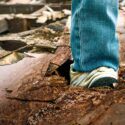You’re on the hunt for the biggest, raddest wave imaginable. You know that the world record for the largest wave ever surfed was set by Rodrigo Koxa in 2017 when he successfully rode a 24 meter (80 ft) wave at Nazaré. And you want to go ever bigger.
But water is heavy. A 10 meter (33 ft) wave with a 20 meter (66 ft) wide lip weighs 410000 kilograms (410 tonnes). If you wipeout, the equivalent weight of four Blue Whales would come crashing down on you. Can you survive if you wipeout?
While surfing sure looks death-defying, the sport has only claimed the lives of four big wave surfers since 2010. But it’s still far from safe. Take Greg Long, a world-renowned big wave surfer. In 2014, he almost walked away from the sport forever after a near death experience off the coast of Southern California.
This experienced surfer fell off while paddling out to a 15 meter (50 ft) wave 160 km (100 miles) away from shore. Greg Long tried to pull himself up to the surface but was hit hard by two more waves. When he finally reached the air, he had no energy and no oxygen left. He was found floating face down in the Pacific Ocean by a three-person rescue team.
How did he survive? What is the most lethal part of surfing? Why is preparation important?
Step 1: Know Your Limits
The best way to survive a The biggest wave for you might look a lot different than the biggest wave for someone like Greg Long. Surfing is a complex sport of physics. Gravity and buoyancy work as opposing forces that build speed and allow surfers to balance on their boards.
Surfers manipulate the forces of gravity and buoyancy through torque. This re-adjustment of weight allows them to control the direction of the board. If you want to ride a big wave safely, you need to be a master at using these principles. Which means you need years and years of training in both surfing and swimming. Don’t get too cocky, and please, no thrill seekers.
Step 2: Track the Waves
Professionals and amateurs alike use technology to track waves for optimal conditions. Waves get their energy from ocean currents and wind. Each wave maintains the same amount of water.
So as a wave moves from the deep open ocean into shallow water, it has to get smaller. And as the land forces the water into a narrower shape, the wave grows in height until it breaks. Hopefully you’ve already done step one and know what big wave is appropriate for your skill level. Now, you just have to track conditions to find that wave.
Step 3: Invest in Safety Gear
Safety technology is extremely important for surfers. The leading cause of fatal injury in surfing is when a surfer drowns after a blow to the head. So making sure you have a quality inflatable vest whenever you go out can keep you alive. Except if you’re Greg Long. He was wearing a state-of-the-art safety vest in 2014. But Long’s vest malfunctioned and did not inflate after he pulled the ripcord. Gnarly luck, dude.
Step 4: Have a Safety Team
Thankfully, Long survived because he had a safety team. While he still suffered severe blunt force trauma to his head, he is alive because his three-person safety team was able to find and reach him via jet skis.
Step 5: Stay Calm
The calmer you are, the slower you use up oxygen. Many surfers train to hold their breath for as long as possible. Having a large lung capacity and the ability to hold your breath can afford you precious, life-saving seconds.
Surfing the biggest wave comes with a big reward and even bigger risks. But as long as you know your limits, track the waves, have the proper gear, a safety team, and stay calm if you wipeout, then you’ll be fine.
Sources
- “Waves Of Physics: The Science Of Surfing – Science Connected Magazine”. 2017. Science Connected Magazine.
- “7 of the Most Famous Big-Wave Surf Spots on the Planet”. 2018. Men’s Journal.
- “The Physics Of Surfing”. scu.edu.
- “Seeking Safety In Big Waves”. Elder, Adam. 2014. The New Yorker.
- “A big wave surfers’ guide to taking calculated risks”. Schrager, Allison. 2017. Quartz.
- “Andrew Cotty’s Back-Breaking Wipeout At Nazaré Wins Worst Wipeout Of The Year”. SURFER Magazine.
- “How Dangerous Is Surfing? – Wavelength Surf Magazine – Since 1981”. Wavelength Surf Magazine – Since 1981.



























